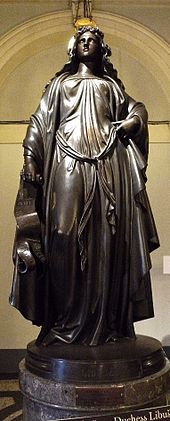Libuše
(GermanLibussaorLibuschaalsoLubossa,Lybussie,Libussie,Libusse) is themythical progenitrixthePřemyslidendynasty inBohemia.
Lore
The oldest written tradition is the Christian legend, which originated in 992–994, possibly in the Břevnov monastery . According to her, the pagan people of the Czechs lived without a law and without a city, like an “incomprehensible animal” until an epidemic broke out. On the advice of an unnamed fortune-teller, they founded Prague Castle and found in Přemysl a man who was only busy plowing the fields. They installed him as ruler and gave him the fortune teller to wife. These two measures freed the country from the plague, and all subsequent rulers came from the family of the plowman.
In the Chronica Boemorum des Cosmas of Prague from the beginning of the 12th century, the fortune teller, now called Libuše, is the daughter of the judge Krok (the successor of the forefather Čech ) and the youngest sister of the healers Kazi and the priestess Teta . She is appointed by her father as the successor to the judge's office. For Cosmas, the wedding with Přemysl is the result of an unsuccessful arbitration award, after which the loser complains that he has to bow to the power of a woman. The offended judge then tells the people where to look for the new ruler and what his name is. After the marriage with Přemysl, Libuše asked the people to found Prague. The final submission of women does not take place until after Libuše's death in the war of the sexes .
On a picture from 1553 (see below left) Libussa is named Goth.Reg. Inscribed Gothic Queen .
There are indications in the form of parallels in Slavic, Scandinavian and Celtic traditions for an interpretation of the story as a myth that falls back on Indo-European traditions. However, both surviving versions testify above all to the use of the material to explain the origin and claim to power of the Přemyslid dynasty that ruled at the time of its creation . In the version of the Cosmas Chronicle, borrowings from the biblical tradition can also be seen.
The modern version of the story as a legend was created in the 19th century by Alois Jirásek in the "Old Bohemian Legends" (Staré pověsti české). An authentic film adaptation of this legend was made by Constantin Werner with the film Pagan Queen - Queen of the Barbarians (2009).
Přemysl and Libuše
by Josef Václav Myslbek (1881)Libuše as National Allegory with Linden Branch by Karel Vítězslav Mašek (1893)
Libuše in literature
Johann Karl August Musäus tells the story of Libuše in his Folk Tales of the Germans . He gives as main sources: The Historia Bohemica (History of Bohemia) by Johannes Dubravius and De Bohemorum origine ac gestis Historia (History of the origin and deeds of the Bohemians) by Enea Silvio Piccolomini , later Pope Pius II.
The figure of Libuše was the subject of numerous works of art:
- Clemens Brentano : The Foundation of Prague , Drama (1812)
- Joseph Carl Bernard (1780–1850): Libussa , "Romantic Opera in 3 Acts" (1822), set to music by Conradin Kreutzer (Kärntnertortheater Vienna, December 4, 1822)
- Franz Grillparzer : Libussa , Tragedy (1848)
- Bedřich Smetana : Libusa , Opera (1881), premiered at the opening of the Národní divadlo
- Miloš Urban : Pole a palisáda , Roman (2006)
- Tereza Vanek : The Dreams of Libussa , historical novel (2008)
- Poem Much Beloved Libuše by Günter Grass (2015)
literature
- Dušan Třeštík : Mýty kmene Čechů . Nakladatelství lidové noviny, 2003, ISBN 80-7106-646-X .
Movies
Pagan Queen - The Queen of the Barbarians ( http://www.imdb.com/title/tt1096997/ )
Web links
Individual evidence
- ^ Cosmas of Prague / Berthold Bretholz: The Chronicle of the Bohemians of Cosmas of Prague. Berlin, 1923, p. 11




